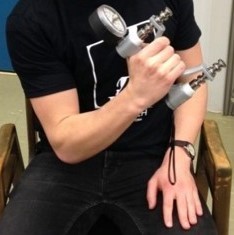Single limb resistance training improves strength not only in the trained limb, but also in similar muscles of the untrained limb. The increase in strength in the untrained limb, commonly known as ‘cross-education’, is due to a strengthening of connections within the brain and spinal cord (Farthing and Zehr, 2014). Single limb training can be used to maintain strength in an immobilised limb (Farthing et al. 2011) and improve strength on the more affected side in individuals after stroke (Dragert and Zehr, 2013; Sun et al. 2018). However, there is limited knowledge on the optimal ‘dose’ of resistance training needed for cross-education, including how often and for how many weeks training must be performed. This has limited its potential use in rehabilitation.
The aim of our study was to determine the minimum number of training sessions required to induce strength gains in an untrained limb after handgrip training using a ‘traditional’ (3x/week for 6 weeks) or daily (i.e. 18 consecutive sessions) protocol in able-bodied participants. A secondary aim was to determine whether ‘daily’ training provided similar strength improvements in a shorter amount of time. Participants in the traditional training group performed five sets of five maximal handgrip contractions during each session. Participants in the daily training group performed the same volume of training over 18 consecutive days.

WHAT DID WE FIND?
Daily training for 18 consecutive days produced similar strength gains in the untrained limb (7.8 ± 6.8%) as traditional training 3 times per week for 6 weeks (12.5 ± 9.3%). However, strength gains in the untrained limb were achieved in half the time with daily training (15 days) compared to traditional training (4 weeks (12 sessions)). We also found that untrained limb strength peaked after 5 weeks of traditional training and did not increase any further. With daily training however, there was no plateau in strength improvements. This may indicate that more than 18 sessions are required to optimise strength increases in the untrained limb after unilateral handgrip training.
SIGNIFICANCE AND IMPLICATIONS
After stroke, the focus of rehabilitation is to optimise improvements in strength and function of the more affected limb in as little time as possible to allow more rapid progression to other rehabilitation activities. Since daily training can produce similar increases in strength in less time, minimising rest days may improve the efficiency of single arm training. This is particularly relevant when improvements in strength of the untrained limb is the focus.
PUBLICATION REFERENCE
Barss TS, Klarner T, Pearcey GEP, Sun Y, Zehr EP. Time course of interlimb strength transfer after unilateral handgrip training. J Appl Physiol 125(5): 1594-1608, 2018.
If you cannot access the paper, please click here to request a copy.KEY REFERENCES
Dragert K, Zehr EP. High-intensity unilateral dorsiflexor resistance training results in bilateral neuromuscular plasticity after stroke. Exp Brain Res 225: 93–104, 2013.
Farthing JP, Krentz JR, Magnus CR a, Barss TS, Lanovaz JL, Cummine J, Esopenko C, Sarty GE, Borowsky R. Changes in functional magnetic resonance imaging cortical activation with cross education to an immobilized limb. Med Sci Sports Exerc 43: 1394–405, 2011.
Farthing JP, Zehr EP. Restoring symmetry : Clinical applications of cross-education. Exerc Sport Sci Rev 42: 70–75, 2014.
Sun Y, Ledwell NMH, Boyd LA, Zehr EP. Unilateral wrist extension training after stroke improves strength and neural plasticity in both arms. Exp Brain Res 236: 2009–2021, 2018.TAGS
AUTHOR BIO
Dr. E Paul Zehr is a Professor at the University of Victoria, an author, and a martial artist. His passion for martial arts spurred his interest in science and how the nervous system controls the movements humans could make in their everyday lives. Dr. Zehr’s research focuses on understanding neuromuscular plasticity (the ability of the human body to recover its activity after neurological traumas such as stroke) and the widespread communication of science using superheroes as metaphors.
Dr. Trevor Barss is a Post-Doctoral Fellow within the Neuroscience and Mental Health Institute and Faculty of Medicine and Dentistry at the University of Alberta. His research interests lie in exploring changes in the neuromuscular system associated with voluntary and electrically evoked muscle contractions to facilitate improved rehabilitation after damage to the nervous system.
